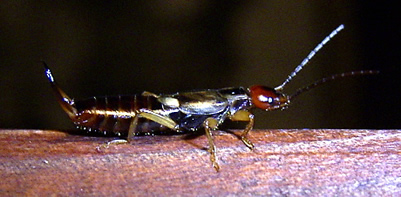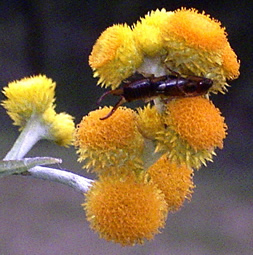

THE EARWIGS (DERMAPTERA) OF BRITISH COLUMBIA

European Earwig (Forficula auricularia), common in gardens in southern BC.
Photo by Diane Williamson
by
R. A. Cannings and G. G. E. Scudder
Copyright © 2005 - All rights reserved
Extracted from the forthcoming publication The Insect Families of British Columbia.
The name “earwig” comes from the old superstition that these insects crawl into the ears of sleeping people, doing predictably nasty damage. This is not a habit, of course, but because earwigs do hide in crevices and crannies, they may rarely enter (harmlessly) the ears of people lying on the ground outside. Presumably, many different kinds of small invertebrates could do this.
Earwigs forage mainly at night, and during the day conceal themselves in all sorts of enclosed spaces, under stones, wood and bark, in vegetation and flowers. Even those species able to fly seldom seem to do so.
The 1350 species of earwigs in the nine families of the Order Dermaptera are mostly tropical in distribution. Some species are native in temperate regions, but few can tolerate cold winters, and all the species recorded in British Columbia are introduced from other lands. The random, alien origin of our earwigs is reflected in the diversity of the small fauna – four species in four genera and three families. Like cockroaches, earwigs are secretive and omnivorous, two characteristics that make them successful hitchhikers with human travelers, and some kinds have become cosmopolitan. But unlike cockroaches, most of these successful immigrants have established themselves out-of-doors and are not normally pests of human habitations. In Canada, because of their foreign origins and dislike of the cold, most species are concentrated on the coasts and in the Great Lakes region. They tend to live in disturbed habitats, on beaches, and in and around gardens and human habitations.

Eupropean Earwig (Forficula auricularia). Photo by Diane Williamson
Most species are omnivorous scavengers although some are known to be exclusively predaceous; in British Columbia, for example, Anisolabis maritima (Bonelli) evidently feeds mainly on invertebrates on ocean beaches. Forficula auricularia Linnaeus, when abundant, can be a pest of garden plants, and is especially fond of flowers. In general, earwigs probably cause serious damage to plants only when insect prey is limited. Prey can be captured with the forceps, although these are also used in courtship and probably mostly in defence; the larger species can give a human finger a painful pinch.
Eggs are laid in underground burrows, usually in batches of 20 to 40. Females of some species, including the widespread Forficula auricularia, guard the eggs and show some care and protection of their young. Family groups often remain associated and semisocial behaviour occurs. Nymphs usually moult four to six times.
Description
The earwig body is small to moderate sized (5-30 mm long, although some foreign species may reach 5 cm), slender, elongate and rather flattened. The mouthparts are chewing. The antennae are filamentous, usually less than half the body length. There are no ocelli. The legs are similar in size and form; the tarsi have three segments. Wings are often absent. When present, the forewings are modified into short, rectangular, veinless, leathery flaps. Hindwings may be absent even if the forewings are developed, but when present, are usually semicircular and pleated, with radiating veins. Each is stowed as a folded packet under the much smaller forewings, and the tips often project from beneath. The paired cerci at the tip of the abdomen are usually unsegmented, and strongly sclerotized into forceps. These pincers, which are the most familiar feature of the order, are usually stronger and more curved in males. The females, except in some primitive species, lack an ovipositor.
References
Vickery. V.R. and D.K.McE. Kevan. 1985. The Insects and Arachnids of Canada. Part 14. The Grasshoppers, Crickets, and related Insects of Canada and Adjacent Regions. Agriculture Canada Research Branch Publication 1777. Ottawa. 918 pp.
Please cite these pages as:
Author, date, page title. In: Klinkenberg, Brian. (Editor) 2021. E-Fauna BC: Electronic Atlas of the Fauna of British Columbia [www.efauna.bc.ca]. Lab for Advanced Spatial Analysis, Department of Geography, University of British Columbia, Vancouver. [Date Accessed]
© Copyright 2021 E-Fauna BC.